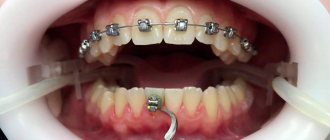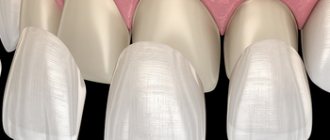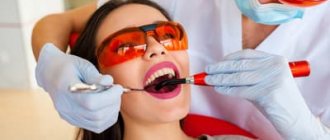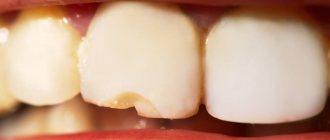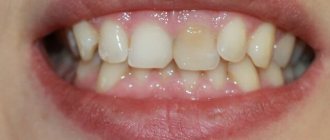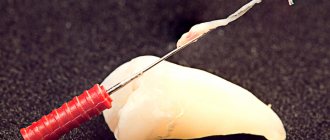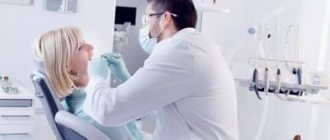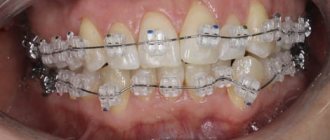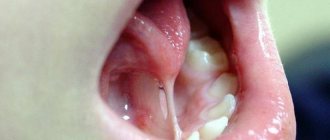In dentistry, complete or partial absence of teeth is called adentia. This pathology can be congenital (anomaly of the development of the dental system) or acquired. The disease is characterized by a violation of the continuity of the dentition. A person cannot chew, speak normally and experiences discomfort from a cosmetic defect in his smile. His diction and articulation are deteriorating, and his gastrointestinal tract is functioning worse.
Both complete and partial adentia are dangerous because, due to tooth loss, deformation of the facial skeleton and diseases of the temporomandibular joint (TMJ) are possible.
Types of pathology
In dentistry, adentia is considered as a primary or secondary defect of the dentition.
- Complete congenital adentia is extremely rare, occurring in approximately 1% of cases.
- Partial secondary adentia is diagnosed in 45–75% of cases.
- Also, complete adentia occurs in 25% of people over 60 years of age.
Depending on the causes and time of occurrence of the pathology, dentists, as mentioned above, distinguish between congenital and secondary tooth loss, as well as edentia of temporary and permanent rows. True adentia is the absence of a tooth germ, and when adjacent crowns merge and there is a delay in their eruption, dentists speak of false adentia.
Taking into account the number of missing teeth, partial and complete edentia are distinguished. The first involves a deficiency of up to 10 units of dentition, usually the upper lateral incisors, second premolars and third molars. If more than 10 teeth are missing, doctors diagnose multiple adentia.
Ask a Question
Causes
The main and only cause of adentia is the absence or death of tooth buds. Primary pathology can be caused by heredity or provoked by various harmful factors acting during the formation of the fetal dental plate.
Complete congenital edentia is an extremely rare phenomenon. Formed due to ectodermal dysplasia. In this case, along with the absence of teeth, patients experience underdevelopment of hair, skin, nails, as well as sebaceous and sweat glands, eye lenses, and nerves.
Other common causes of pathology include the following:
- disturbance of mineral metabolism during the period of intrauterine development of the fetus against the background of diseases of the mother during pregnancy;
- illnesses in early childhood;
- heredity;
- disruption of the endocrine system;
- disruptions in the development of ectoderm - the outer germ layer of the embryo;
- treatment of concomitant diseases, including malignant neoplasms;
- chemotherapy, treatment with ionizing radiation;
- osteomyelitis and other purulent inflammations of the jaws.
The causes of secondary tooth loss in the process of life can be untreated caries, pulpitis, periodontitis, dental trauma, phlegmon, abscesses, illiterate provision of dental or orthopedic care, as well as other pathologies of the teeth and gums.
Adentia: what is it and why does it occur?
This is a fairly common pathology in dentistry, which is characterized by the absence of teeth of varying degrees of severity. It can occur in both children and adults. Based on the nature of its occurrence, it is divided into primary (congenital) and secondary (acquired).
The congenital disease is characteristic of childhood, and the first signs appear before 2 years of age. This is a rare diagnosis. But the acquired form is diagnosed much more often. Usually typical for people of mature age. With age, the risk of developing the disease increases. For example, after 50 years, more than 60% of older people have some type of edentia.
What are the reasons that teeth begin to fall out?
Since congenital disease is rare, the exact reasons for its development in children have not yet been established. But several possible factors can be identified:
- Pathological heredity, due to which the formation of tooth buds simply does not occur.
- Negative effects on the fetus during pregnancy. Impaired development of the embryo can be caused by illness of the mother, taking medications, or exposure to harmful substances.
- Chronic and advanced dental diseases of primary teeth, which lead to insufficient formation of the rudiments of permanent teeth.
Important! Congenital adentia is usually diagnosed in early childhood (up to 1.5 years). But often this diagnosis is false due to the long eruption of baby teeth. Sometimes you just need to wait and your baby will get teeth.
The causes of secondary pathology can be:
- Numerous caries.
- Inflammatory periodontal diseases – gingivitis, periodontal disease, periodontitis.
- Dentist errors or poor quality treatment that lead to the need for tooth extraction.
- Injuries to the dentition or maxillofacial joint.
- Age over 50 years.
- Oncological diagnoses.
- Chronic metabolic diseases, such as diabetes.
People who neglect oral hygiene and rarely visit the dental office are at risk.
Complications
Adentia leads to a variety of physical and aesthetic complications:
- in the area where a tooth is missing, the unloaded bone gradually atrophies;
- the face may become asymmetrical, lip closure is disrupted, and the chin and nasolabial folds deepen. Often the position of the corners of the mouth changes, they begin to sink;
- underdevelopment of the jaws occurs. It is expressed more strongly the more teeth are missing, various dentofacial deformations appear;
- with multiple edentia of the lower jaw, its strong protrusion and deep bite are observed;
- with anomalies of the upper jaw, the lower dentition begins to overlap the upper one;
Underdevelopment of the jaws is not observed in all cases, and not all children and adults express it in the same way. However, in all cases, edentia leads to negative changes in appearance.
With complete or multiple edentia, the bite is formed incorrectly and the function of oral digestion is disrupted. The food is poorly crushed, and the patient is forced to give up many tasty dishes. We should not forget that with this pathology a person’s self-esteem decreases, he begins to worry about the fact that he looks unattractive, withdraws into himself and is less likely to make contact with people.
Nylon or silicone dentures
This type of prosthesis is similar to acrylic, but made from more modern and safe materials. Nylon is softer and more elastic, the prosthesis looks better than acrylic ones, but they are also fixed - not quite reliably. Due to the softness of the system, these dentures will not allow you to chew food well; in addition, they load the gums in this way, which over time leads to atrophy of the jaw bone tissue.
Nylon dentures have the following advantages: the absence of allergic reactions, due to the absence of pores in the material, they do not absorb moisture and odors, getting used to them is faster than acrylic ones, they do not rub the gums, are practically invisible to others and have antimicrobial properties.
The disadvantages include: uneven load distribution, short lifespan (3-4 years) and impossibility of repair, high price compared to acrylic ones. Another disadvantage is the problem of a massive base, which, covering the entire palate, causes problems with diction. The elasticity of the nylon prosthesis material is also its disadvantage. Due to the flexible base, the load during chewing is transferred only to the area where food is currently being chewed, this leads to accelerated atrophy of bone tissue.
Edentia of the upper jaw
The upper jaw is more often than the lower jaw and is subject to various types of anomalies. As a rule, patients have symmetrical hypodentia of two teeth. And since the front teeth are involved in sound production and form the purity of pronunciation, this type of deformation is the most noticeable. The patient's speech becomes lisping and slurred, the smile “creeps away”, and saliva splashes.
Edentia of the lower jaw
The lower jaw has a small prosthetic bed, so when edentulous, the tongue begins to take the place of the lower teeth. As a result, the patient’s diction changes significantly and his well-being worsens.
Diagnostic methods at the dentist
For an orthopedic dentist, even a primary external examination of the face can indicate a pathological condition - adentia. Symptoms and treatment of the disease are interconnected, so correct diagnostic measures are important.
The main technique is X-ray images of HF and LF. When identifying a congenital form of the disease, to determine the rudiments.
Patients under 18 years of age should choose OPTG - a panoramic Rg image to see the full development of bone structures and the TMJ.
It is also necessary to determine the likely limitations to the implementation of therapy - inflammation/neoplastic growths in the mouth, roots of damaged units, periodontal tissue diseases.
- Edentia of the upper jaw
On the bone structures of the upper jaw, there are more often various anomalies than on the lower jaw (symmetrical deficiency of two units - mainly the second incisors of the “twos”). The frontal group of teeth takes part in sound production and pronunciation.
- Edentia of the lower jaw
There is not much space in the lower jaw for a denture, so in the absence of teeth, the tongue will take up all the free space, which means a deterioration in speech and food consumption.
Diagnosis and treatment
To diagnose the disease, the dentist needs a detailed examination of the patient’s oral cavity. The doctor asks the patient a number of things:
- causes and timing of tooth loss;
- information about previous diseases;
- data on dental prostheses previously used by the patient.
During the examination, the dentist notes the asymmetry of the face, the severity of the chin and nasolabial folds, the degree of reduction in the height of the lower part of the face, the presence of a jam, the nature of the closure of the lips, the topography of the transitional fold, the degree of mouth opening, the nature of the jaw relationship. The specialist also determines the presence of crunching in the joints, pain when moving the lower jaw and diagnoses the degree of atrophy of the alveolar processes.
The examination necessarily includes palpation of the oral cavity and radiography of the TMJ. Based on the data obtained, the doctor determines further treatment tactics (prosthetics), selects the appropriate type of prosthesis and impression material for the patient.
Bite with complete absence of teeth
With complete edentia, the jaw looks unaesthetic, and the shape of the patient’s face changes significantly. In this situation, specialists need to recreate the correct bite so that the prosthesis does not protrude or sink.
In order for the prosthesis to fit correctly, correcting aesthetic and functional problems caused by edentia, it is necessary:
- calculate the occlusal height of the upper jaw;
- form a prosthetic plane;
- determine the height of the lower facial region;
- determine the central relationship of the jaws and fix it with notches.
To determine central occlusion, the doctor holds the corners of the patient's mouth. After the patient swallows saliva, the jaws close correctly.
Treatment of adentia in children
It is important for parents to understand that treatment of children who experience pathological tooth loss must be carried out without fail. For example, if a child lacks primary teeth in the anterior and lateral segments, the row may not form correctly during adolescence.
Children's adentia is characterized by:
- delay in changing permanent teeth;
- asymmetrical teething;
- unilateral preservation of primary teeth;
- non-loss of a baby tooth and its fusion with a depression in the jaw bone.
If at least one of these signs is detected, the child should definitely be shown to an orthodontist.
The choice of orthopedic design depends on the type of pathology and the condition of the small patient’s oral cavity. Children most often have fixed bridges installed - cantilever or sliding. To fix the structure, crowns are installed. Children respond well to prosthetics and adapt well to new designs.
Bridges can also be installed in young patients, but such designs are more suitable during the period of late mixed and permanent dentition. The most successful designs are considered to be sliding bridges. The only drawback of such a system is the formation of a gap when the structure moves apart and food gets into it.
Bridges are sometimes installed for preventive purposes to preserve space in the dentition.
During the period of early mixed and temporary dentition, removable plate dentures are used, which do not retard the growth of the jaw bones.
Which implants to choose?
Today there are more than 3,000 implant systems in the world. However, not all of them can boast a long history of observations and clinical trials around the world. There are also some implant systems that, despite their reliability, are not very common in Russia. This may lead to difficulties in terms of delivery of original components of implant systems.
It is worth choosing only generally recognized implant systems, which are used by different doctors independent of each other. Otherwise, the patient risks finding himself in a situation where no one can help him.
An important point when choosing an implant system is the type of implant-abutment connection. It determines how long the implant will last. The most reliable today is the conical implant-abutment connection with the effect of switching platforms. It is able to withstand greater loads compared to a flat connection, is leak-tight and does not cause resorption of bone tissue around the implant.
The healing of implants is affected by the purity of the titanium from which they are made. The most common is Grade 4 - commercially pure titanium. Grade 1,2,3 alloys are even purer. Grade 5 – less pure, contains impurities of vanadium and aluminum.
The surface of each implant is a unique patented technology, because... It is on the surface of the implant that osseointegration occurs—the fusion of the implant with the bone tissue. Serious implant manufacturing companies conduct a lot of research, proving that their implants are integrated not only in standard situations, but also, for example, in people suffering from diabetes or bleeding disorders. The following systems meet all these requirements: Straumann (Switzerland), Ankylos (Germany), Astra tech (Sweden), Nobel biocare (USA/Sweden). Among the inexpensive systems, we can highlight Osstem implants (South Korea). They have proven themselves throughout the world as a reliable and economical implant system.
Treatment of adentia in adults
Adult patients are offered various types of removable and fixed dentures. Prosthetics on implants, installation of bridges on four implants and other prosthetic options at the patient’s choice are possible. Depending on the condition of his dental system, financial capabilities and wishes, dentists, as a rule, offer several treatment options to choose from.
When choosing a treatment method, it is important to understand the features of each design. The doctor, based on the condition of the patient’s oral cavity, offers him a choice of several prosthetic options.
Removable dentures
Partial or complete dentures should be replaced every 1.5 to 2 years. Therefore, even with complete loss of teeth, dentists offer an alternative type of prosthetics based on implants.
Clasp dentures
Dentures on a metal frame, on which an acrylic base is installed, and artificial teeth are installed on it. This solution makes it possible to significantly lighten the design of the prosthesis, making it thinner and more comfortable.
Bridges
In case of partial edentia, it is possible to install bridges. The non-removable structure is fixed on adjacent non-grindable teeth.
Implant-supported prosthetics
Implant-supported prosthetics are considered the most reliable and aesthetic way to restore dentition. The main advantages of this type of bone implantation include:
- long service life of the structure;
- aesthetic appearance;
- no need to grind adjacent teeth.
A denture installed on implants completely replaces missing teeth and performs a functional and aesthetic task.
Prices
| Service | Price |
| Removable acrylic (plate) dentures | from 15,200 rub. |
| Dental bridges | from 25,800 rub. |
| Nylon dentures | from 34,900 rub. |
| Clasp dentures | from 48,500 rub. |
| Complete dental prosthetics on implants | from 215,000 rub. |
| All-on-6 prosthetics | from 221,000 rub. |
To avoid possible misunderstandings, please clarify the cost of services in clinics with the administrator or during a consultation with a doctor. Prices on the website are not a public offer.
Sign up for a consultation
Prevention of edentia
The best prevention is competent, timely oral care. Regular brushing of teeth and gums, preventive examinations at the dentist twice a year, giving up bad habits, switching to a balanced diet - all this will help keep your teeth healthy and strong for as long as possible.
If you or your child is experiencing this disease, do not delay visiting the dentist. Experienced therapists, orthopedists and implantologists at STOMA clinics will help solve the problem of partial or complete absence of teeth: they will select a comfortable and aesthetic prosthesis that will significantly improve the quality of life, make you more confident and beautiful.
Call and make an appointment by phone: +7 (812) 416-94-37. Our clinics are located in different areas of St. Petersburg and are open from Monday to Saturday, from 9 to 21 hours.
